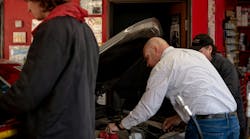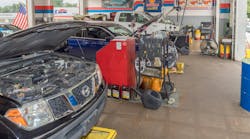Car repair has been a time-honored tradition between fathers and sons, passed from generation to generation. Saturdays were made to be spent underneath a car, tinkering with the engine or some part of the undercarriage, and learning about the inner workings of a vehicle.
I hear less and less about families bonding under the hood of a car these days, and I have a sneaking suspicion that advancing technology has a lot to do with it.
Nowadays, you almost need an IT degree to understand how a car works. From onboard Wi-Fi, to DVD players and computers monitoring everything from brakes to oil change indicators, technology has encroached on the car scene, making repairs increasingly difficult to complete, especially for independent shops.
To combat this imbalance, the Auto Care Association (ACA) and the Coalition for Auto Repair Equality (CARE) joined forces to create Right to Repair legislation.
“Right to Repair ensures that independent repair facilities — those that are not car dealers — have access to all the information, tools and software [needed to work on late model, computer-controlled vehicles] that dealers have from the vehicle manufacturers,” said Aaron Lowe, senior vice president, regulatory and government affairs, Auto Care Association.
So why was Right to Repair such an important issue? According to righttorepair.org, “Current automotive technology is being used to successfully ‘lock out’ car owners from being able to repair and maintain their own vehicles. Modern automobiles contain many computers that control virtually every component, such as the braking system, steering mechanism, air bags, ignition, climate control system, dome and check engine lights, fuel injection, tire pressure and some oil and tire changes. This means that later model cars can only be serviced and repaired at automobile dealerships, which makes shopping around for the best prices and most convenient service locations impossible.”
The Right to Repair law was passed in Massachusetts but doesn’t cover the other 49 states in the U.S. However, an agreement, known as the Memorandum of Understanding (MOU), was signed by ACA, CARE and the vehicle manufacturers represented by the Alliance of Automobile Manufacturers and the Global Automakers to ensure the rest of the United States will benefit from Right to Repair.
“The goal of [Right to Repair] is to have one national agreement so we don’t have to fight this battle state-by-state,” Lowe said. “The hope is now that the [car manufacturers] have signed this MOU, if there are any issues, they’ll be resolved through the MOU process.”
With the signing of the MOU, car companies agreed to abide nationwide with Massachusetts’ Right to Repair law and will be required to:
• Immediately make available to consumers and the independent vehicle repair industry on “fair and reasonable terms,” the same tools, software and repair information that they make available to their franchised dealers.
• Beginning with the 2018 model year, establish websites or “clouds” that will contain the same information and software that dealers have access to as part of their proprietary tools.
• Vehicle manufacturers will provide access to the vehicles’ diagnostic computers using a standardized vehicle interface that meets either the Society of Automotive Engineers (SAE) J 2534 or International Standards Organization (ISO) 22900 standards.
If an independent shop is having a hard time finding information to properly diagnose a car, there are steps they can take to help them under the MOU.
“Each car company has a website with all of their information, so [the shop owner] would try the website first,” Lowe said. “If they couldn’t find [the information they need] on the website, they would want to file a complaint.”
The shop could either directly contact the vehicle manufacturer or go through the National Automotive Service Task Force (NASTF) website to lodge a service information request (SIR). You can file a SIR through the NASTF website at: www.nastf.info/Information_Request_Form.html. The manufacturer then has 30 days to respond.
“If they still can’t get the information from the manufacturer, then there’s a dispute resolution panel (DRP) that would be put together to try to determine whether that information should have been provided [to the shop owner], ” Lowe said.
The DRP will then be comprised of two people appointed by the automakers and two people by CARE and ACA. Rounding out the panel will be a fifth, non-partisan individual.
Right to Repair isn’t just a U.S. issue. There are other countries that have taken vehicle manufacturers to task with their own Right to Repair legislation. Because of this, ACA co-hosted the Global Right to Repair Meeting at the 2014 Automechanika in Frankfurt, Germany, with FIGIEFA (Federation Internationale Des Grossistes, Importateurs and Exportateurs en Fournitures Automobiles).
“This was our second [meeting,] and it’s part of a continued, ongoing effort that ACA is working with other similar associations around the world to share information. I think it helps a lot of the countries that may not be as far along in Right to Repair [as we are],” Lowe said. “We primarily have people from the European Union (EU), Australia, South Africa and Brazil. We share ideas and discussions on progress that’s been made on the Right to Repair effort globally.”
Sharing information between the U.S. and our friends abroad allows the industry to understand issues that could be arising overseas and potentially drift across the pond.
“I think the major impact [of the Global Right to Repair meeting] is just being able to gauge what areas where manufacturers may not have been cooperative or have been cooperative in other countries, because we tend to find that a lot of the issues are global now, not just U.S.-based,” Lowe said. “Through sharing information, we’re able to help our colleagues overseas and they provide us input on issues that may be coming up in other countries that we may or may not be aware of yet in [the U.S.]”
These global meetings are also shifting their focus to other issues car owners and independent shops are facing: telematics.
“We’re also looking at telematics and how cars transmit information wirelessly from the vehicle to the manufacturer and how a global solution might be developed to try to ensure that independents have access to that information as well, because those aren’t necessarily covered under the Right to Repair efforts,” Lowe said.
With the Right to Repair law in effect in Massachusetts and the MOU signed by all parties, accessing information, tools and software from manufacturers will soon be as easy as typing in a web address. Thanks to ACA, CARE and aftermarket groups from the EU, quick lubes across the U.S. and overseas will have the information they need from vehicle manufacturers, benefiting everyone involved.





